What's inside
What's inside
 Key Ingredients
Key Ingredients

 Benefits
Benefits

 Concerns
Concerns

 Ingredients Side-by-side
Ingredients Side-by-side

Water
Skin ConditioningKaolin
AbrasiveSorbitol
HumectantBentonite
AbsorbentButylene Glycol
HumectantSilica
AbrasiveCI 77891
Cosmetic ColorantVaccinium Macrocarpon Seed
AbrasivePentylene Glycol
Skin Conditioning1,2-Hexanediol
Skin ConditioningSimmondsia Chinensis Seed Oil
EmollientCaprylyl Glycol
EmollientXanthan Gum
EmulsifyingPolysorbate 60
EmulsifyingPolyacrylamide
CI 77492
Cosmetic ColorantGlycerin
HumectantC13-14 Isoparaffin
EmollientCurcuma Longa Root Extract
MaskingAscorbyl Glucoside
AntioxidantTrisodium Ethylenediamine Disuccinate
Laureth-7
EmulsifyingEucalyptus Globulus Leaf Oil
PerfumingCamellia Oleifera Leaf Extract
AstringentMentha Piperita Extract
CleansingMenthol
MaskingEpilobium Angustifolium Flower/Leaf/Stem Extract
Skin ConditioningAminomethyl Propanol
BufferingVaccinium Macrocarpon Seed Oil
Skin ConditioningWater, Kaolin, Sorbitol, Bentonite, Butylene Glycol, Silica, CI 77891, Vaccinium Macrocarpon Seed, Pentylene Glycol, 1,2-Hexanediol, Simmondsia Chinensis Seed Oil, Caprylyl Glycol, Xanthan Gum, Polysorbate 60, Polyacrylamide, CI 77492, Glycerin, C13-14 Isoparaffin, Curcuma Longa Root Extract, Ascorbyl Glucoside, Trisodium Ethylenediamine Disuccinate, Laureth-7, Eucalyptus Globulus Leaf Oil, Camellia Oleifera Leaf Extract, Mentha Piperita Extract, Menthol, Epilobium Angustifolium Flower/Leaf/Stem Extract, Aminomethyl Propanol, Vaccinium Macrocarpon Seed Oil
Glycerin
HumectantSucrose
HumectantCetyl Ethylhexanoate
EmollientButyrospermum Parkii Butter
Skin ConditioningCaprylic/Capric Triglyceride
MaskingCetyl Alcohol
EmollientGlucose
HumectantCitrus Paradisi Fruit Extract
Skin ConditioningMicrocrystalline Wax
Emulsion StabilisingGlyceryl Stearate
EmollientSorbitan Stearate
EmulsifyingOlea Europaea Fruit Oil
MaskingSorbitan Sesquioleate
EmulsifyingPEG-100 Stearate
Simmondsia Chinensis Seed Oil
EmollientCellulose
AbsorbentCalamine
AbsorbentTocopheryl Acetate
AntioxidantRubus Idaeus Seed Oil
EmollientKaolin
AbrasiveQuartz
Abrasive1,2-Hexanediol
Skin ConditioningBisabolol
MaskingCitrus Grandis Peel Oil
MaskingButylene Glycol
HumectantLimonene
PerfumingGlycerin, Sucrose, Cetyl Ethylhexanoate, Butyrospermum Parkii Butter, Caprylic/Capric Triglyceride, Cetyl Alcohol, Glucose, Citrus Paradisi Fruit Extract, Microcrystalline Wax, Glyceryl Stearate, Sorbitan Stearate, Olea Europaea Fruit Oil, Sorbitan Sesquioleate, PEG-100 Stearate, Simmondsia Chinensis Seed Oil, Cellulose, Calamine, Tocopheryl Acetate, Rubus Idaeus Seed Oil, Kaolin, Quartz, 1,2-Hexanediol, Bisabolol, Citrus Grandis Peel Oil, Butylene Glycol, Limonene
 Reviews
Reviews

Ingredients Explained
These ingredients are found in both products.
Ingredients higher up in an ingredient list are typically present in a larger amount.
1,2-Hexanediol is a synthetic liquid and another multi-functional powerhouse.
It is a:
- Humectant, drawing moisture into the skin
- Emollient, helping to soften skin
- Solvent, dispersing and stabilizing formulas
- Preservative booster, enhancing the antimicrobial activity of other preservatives
Butylene Glycol (or BG) is used within cosmetic products for a few different reasons:
Overall, Butylene Glycol is a safe and well-rounded ingredient that works well with other ingredients.
Though this ingredient works well with most skin types, some people with sensitive skin may experience a reaction such as allergic rashes, closed comedones, or itchiness.
Learn more about Butylene GlycolGlycerin is already naturally found in your skin. It helps moisturize and protect your skin.
A study from 2016 found glycerin to be more effective as a humectant than AHAs and hyaluronic acid.
As a humectant, it helps the skin stay hydrated by pulling moisture to your skin. The low molecular weight of glycerin allows it to pull moisture into the deeper layers of your skin.
Hydrated skin improves your skin barrier; Your skin barrier helps protect against irritants and bacteria.
Glycerin has also been found to have antimicrobial and antiviral properties. Due to these properties, glycerin is often used in wound and burn treatments.
In cosmetics, glycerin is usually derived from plants such as soybean or palm. However, it can also be sourced from animals, such as tallow or animal fat.
This ingredient is organic, colorless, odorless, and non-toxic.
Glycerin is the name for this ingredient in American English. British English uses Glycerol/Glycerine.
Learn more about GlycerinKaolin is a clay. It is used for oil control and to help minimize pores. Like other clays, kaolin has the ability to absorb excess sebum or oil. This can help clean out pores and mattify the skin.
Some types of kaolin may have exfoliating properties. When water is added to kaolin, it becomes a paste with small abrasive particles.
Most kaolin is a white color, but may be pink/orange/red depending on where it comes from.
The name 'kaolin' comes from a Chinese village named 'Gaoling'. Kaolin clay comes from rocks rich in kaolinite. Kaolinite, the mineral, has a silicate layered structure. Kaolinite is formed from chemical weathering of aluminum siilicate minerals.
Besides skincare, kaolin is commonly used to make glossy paper, in ceramics, toothpaste, and as medicine to soothe stomach issues.
Learn more about KaolinThis oil comes from the seeds of the desert shrub called Jojoba. It is more commonly known as jojoba oil, a non-comedogenic oil.
Jojoba oil does not contain fragrance and has many fatty-acids, making it a great soothing ingredient.
It also contains Vitamin E, a great moisturizing ingredient. Vitamin E is also an antioxidant and protects your skin against oxidative damage.
This ingredient humectant properties, meaning it helps draw moisture from the air. This helps keep your skin hydrated.
While jojoba has antibacterial properties, it is only able to kill some strains of bacteria.
Studies also show it helps in wound healing. In fact, Indigenous cultures have used jojoba as a moisturizer and to help treat burns for centuries.
Fun fact: Jojoba oil similar to natural human skin sebum, so it has a great effect on dry skin. It is also promising with helping to regulate sebum production.
Due to its fatty acid content, Jojoba oil may not be fungal acne safe. We recommend speaking with a professional if you have any concerns.
Learn more about Simmondsia Chinensis Seed Oil